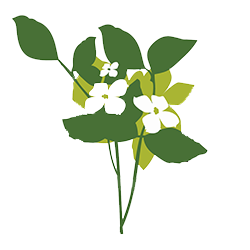Eastern Flowering Dogwood

Species description
Eastern Flowering Dogwood (Cornus florida) is a small (3-10 metres in height), showy tree with a layered branching pattern and simple, oval leaves that are arranged in pairs along the branch. The bark of larger trees is brownish-grey in colour and separated into scales, giving it the appearance of alligator skin. Tiny yellow flowers grow in clusters of two to six at the ends of small branches and are surrounded by four conspicuous white leaves that look like petals. Their berries turn bright red in late summer.
In Canada, Eastern Flowering Dogwood is found only in southwestern Ontario in the Carolinian Zone (the small area of Ontario that extends southwest of Toronto towards Sarnia and down to the shores of Lake Erie). A total of 180 populations have been documented in the province. It occurs in a variety of vegetation communities, and is often found under taller trees in mid-age to mature deciduous or mixed forests; it is also found along fencerows and roadsides. The species prefers lighter, acidic sandy-loam soils with good drainage. The species shows some adaptation to forest fire, and is able to re-sprout profusely from its rootstock following fire. A map of the provincial distribution of Eastern Flowering Dogwood is available on the Government of Ontario’s species at risk website.
Across its North American range, Eastern Flowering Dogwood is undergoing a steep population decline due to the dogwood anthracnose fungus (Discula destructiva). In Ontario, the rate of decline has been estimated at seven to eight percent annually. Other threats include forest succession, herbivory by White-tailed Deer, habitat loss, and insects and pests. These probably exacerbate the species’ decline, but are relatively minor in comparison to the impact of the aggressive anthracnose fungus.
Eastern Flowering Dogwood is listed as endangered at both the provincial (Species at Risk in Ontario List) and federal (Schedule 1 under the Species at Risk Act) levels. Globally, it is considered to be secure.
Provincial status
The Committee on the Status of Species at Risk in Ontario (COSSARO) assessed Eastern Flowering Dogwood as endangered. Following this assessment, it was added to the Species at Risk in Ontario List in 2009. In future assessments, COSSARO may consider information regarding the species’ threats and trends in population and distribution gained through protection and recovery actions.
Species and habitat protection
As an endangered species, Eastern Flowering Dogwood has been protected from being killed, harmed, harassed, captured or taken since 2009.
In addition, the habitat of Eastern Flowering Dogwood is protected from being damaged or destroyed; habitat protection has been in place since 2009. Habitat protection was initially based on the general habitat definition in the ESA. The habitat of Eastern Flowering Dogwood is now protected through a habitat regulation that was developed in 2011.
Protecting Eastern Flowering Dogwood and enforcing the regulation protecting the specific habitat of the species are key components in the implementation of the Endangered Species Act, 2007 (ESA or “the Act”) and continue to be government-led actions, as identified in the government response statement. As an endangered species, Eastern Flowering Dogwood has been protected from being killed, harmed, harassed, captured or taken since it was listed in 2009. In addition, the habitat of Eastern Flowering Dogwood is protected from being damaged or destroyed; habitat protection has been in place since 2009. Habitat protection was initially based on the general habitat definition in the ESA. The habitat of Eastern Flowering Dogwood is now protected through a habitat regulation that was developed in 2011. Further information on species and habitat protection is provided in section 2.3 of the introductory chapter of this document.
The government developed the habitat regulation (Ontario Regulation 242/08, section 24.2) for Eastern Flowering Dogwood within the timeframe required by the ESA. It provides clarity to the public and others on what areas are protected as Eastern Flowering Dogwood habitat, and was developed based on consideration of both the habitat needs of the species and comments received through public consultation.
Any person who negatively impacts Eastern Flowering Dogwood or its habitat without prior authorization may be prosecuted under the ESA.
Recovery strategy
A recovery strategy for Eastern Flowering Dogwood was completed on February7nbsp;18, 2010, which was within the timeframe required by the ESA. It represents best science advice to government. The strategy identified the habitat needs of Eastern Flowering Dogwood and the threats that it faces, while recommending objectives and approaches for protecting and recovering the species. The recovery strategy also included recommendations on the areas of habitat to be considered in the development of a habitat regulation.
Government response statement
The Ministry of Natural Resources and Forestry (“the Ministry”) published the government response statement (GRS) for Eastern Flowering Dogwood on November 18, 2010, which was within the timeframe required by the ESA. The GRS is government policy that contains the Government of Ontario’s goal for the recovery of Eastern Flowering Dogwood.
Recovery goal
The government's goal for the recovery of Eastern Flowering Dogwood is to protect and conserve existing populations, reduce its rate of decline, and where possible, restore populations of the species across its range in southern Ontario.
To help achieve this goal, the government leads and supports a number of recovery actions. Common actions for the government to lead as it works towards achieving a species’ recovery goal are provided in section 2.5 of the introductory chapter of this document. The GRS for Eastern Flowering Dogwood also outlines 11 actions for which the Ministry is using a variety of methods to support others to undertake. These government-supported actions fall under the objectives identified in the GRS, which are:
- Develop, implement and assess management approaches for dogwood anthracnose and other threats in natural stands;
- Undertake monitoring of health, threats and possible resistance to dogwood anthracnose;
- Identify and protect existing populations of Eastern Flowering Dogwood across their range in southern Ontario; and
- Where possible, restore habitat and/or populations of Eastern Flowering Dogwood.
The subsequent sections of this chapter provide a review of actions that the government has led or supported to help achieve the recovery goal for Eastern Flowering Dogwood.
Government funded projects
An important government-led action in the GRS for Eastern Flowering Dogwood is to support partners to undertake activities to protect and recover the species. Through the Species at Risk Stewardship Fund the Ministry has supported a total of 24 projects designed to contribute to the protection and recovery of Eastern Flowering Dogwood. Three of these projects ($63,461) focused exclusively on the species, while the other 21 projects ($862,139) focused on multiple species at risk, including Eastern Flowering Dogwood. In addition to the funding provided through the Species at Risk Stewardship Fund, partners focusing exclusively on Eastern Flowering Dogwood reported that they were successful in securing additional funding and in-kind support ($69,630) from other sources, as did partners with projects designed to benefit multiple species at risk, including Eastern Flowering Dogwood ($1,701,263). These values for additional funding and in-kind support include the estimated value of the time and expertise provided by volunteers, which are outlined below.
Stewardship partners also reported that the province’s funding support helped them to involve 39 individuals who volunteered 570 hours of their time toward protection and recovery activities that focused exclusively on Eastern Flowering Dogwood, which has an estimated value of $15,760. As well, a total of 1,214 individuals volunteered 19,625 hours of their time toward protection and recovery activities for multiple species at risk, including Eastern Flowering Dogwood, which has an estimated value of $499,650.
Species at Risk Stewardship Fund
-
 $63,461
$63,461for Eastern Flowering Dogwood exclusively
-
 $862,139
$862,139for multi-species projects that included Eastern Flowering Dogwood
-
 $1,770,893
$1,770,893in additional funding and in-kind support
-
 24
24exclusively on the species
-
 1,253
1,253volunteers
-
 20,195
20,195hours
-
 38,954
38,954people received outreach
-
 1,061
1,061hectares of habitat enhanced
Stewardship partners reported that through both their efforts and the efforts of their volunteers to implement actions contained in the GRS, they were successful in enhancing 1,061 hectares of habitat that will benefit multiple species at risk, including Eastern Flowering Dogwood. In addition, stewardship partners reported providing focused outreach on Eastern Flowering Dogwood to 172 individuals, and ecosystem-based outreach on multiple species (including Eastern Flowering Dogwood) to 38,782 individuals. The remainder of this section highlights three projects that were supported through the Species at Risk Stewardship Fund and their corresponding government-supported recovery actions.
One stewardship partner implemented and monitored the effects of different techniques to manage dogwood anthracnose fungus. This included undertaking prescribed burns and thinning a white pine plantation, in which Eastern Flowering Dogwood occurred with subsequent monitoring of the health of known Eastern Flowering Dogwood populations to help assess the effectiveness of these techniques for managing the fungus. The partner’s ongoing monitoring and evaluation work will provide valuable information on the effects of different techniques for managing dogwood anthracnose fungus. In addition to their investigation into the effects of different management techniques, the partner engaged numerous volunteers and raised awareness of the threats to Eastern Flowering Dogwood and communicated management options that can be implemented to promote its recovery. This project supports the GRS action to consider habitat management within the range of Eastern Flowering Dogwood such as the removal of some conifers in former conifer plantations in order to promote natural seeding, growth and dispersal of Eastern Flowering Dogwood and other native species.
In another project, a stewardship partner engaged landowners, land stewards, volunteers and university students in the improvement and restoration of Eastern Flowering Dogwood habitat in order to share best management practices and document their effectiveness. Methods included prescribed burns, managing invasive species, volunteer-led monitoring and hands-on restoration opportunities. The results of the project included sharing knowledge of habitat management techniques, distributing habitat management protocols and sharing information related to habitat management techniques with stewardship partners. This project supported the high priority GRS action that focusses on developing and distributing best management practices for Eastern Flowering Dogwood stands.
Another stewardship partner conducted a research study that supports the high priority GRS action to develop and implement a monitoring program that includes identifying significant or anthracnose resistant populations and potentially resistant trees or stands of the species in Ontario. The partner compared genetic data from Eastern Flowering Dogwood at sites that showed little to no infection by anthracnose with data from sites that have suffered from anthracnose. Based on the data for the trees at sites showing little to no infection, the partner found that overall, genetic diversity was high within populations and comparable between young and mature trees, and that populations showed little sign of genetic isolation. Although the partner’s results indicated that none of the sampled trees were from the anthracnose-resistant Appalachian Spring cultivar, it was found that Eastern Flowering Dogwood in Ontario comprises two genetic lineages. The partner plans to investigate the possibility that one of the lineages may be more resistant to anthracnose infection than the other. The partner also plans to analyze ecological and environmental data to identify factors that may increase susceptibility to anthracnose infection and to generate a database that will classify the perceived threat level for each population of Eastern Flowering Dogwood that was assessed. The results of the study are important to help inform future recovery efforts, such as to reduce the rate of decline and, where possible, assess possible sources for restoring populations of the species across its range in southern Ontario.
Efforts to minimize adverse effects on and create an overall benefit for eastern flowering dogwood
Supporting partners to undertake activities to protect and recover Eastern Flowering Dogwood, such as through permits and their associated conditions, is an important government-led action identified in the GRS for the species. A total of three permits have been issued for Eastern Flowering Dogwood since the species has been protected under the ESA, including one ‘health or safety permit’ (i.e., 17(2)(a) permit) related to maintenance of hydro corridors. One ‘protection or recovery permit’ (i.e., 17(2)(b) permit) was issued for collection of specimens for public herbaria during an inventory of plant species at risk that occur along the Lake Erie shoreline; the inventory also included surveys that endeavoured to determine population size, distribution, health and reproductive status of Eastern Flowering Dogwood and other plant species at risk, as well as type, quality and extent of suitable habitat. Lastly, one ‘overall benefit permit’ (i.e., 17(2)(c) permit) was issued related to the construction of a private residence. Several of the conditions attached to these permits implement government-supported actions identified in the GRS for Eastern Flowering Dogwood, including:
- Restoring habitat by implementing a five-year Habitat Improvement Plan that creates and maintains gaps in the overhead canopy of a specified number of hectares of forested area to promote Eastern Flowering Dogwood growth and reproduction;
- Keeping unauthorized recreational vehicles off the property to avoid damage to the habitat of Eastern Flowering Dogwood; and
- Testing best management practices through tending and monitoring of six transplanted/newly planted Eastern Flowering Dogwood trees for five years and reporting the results.
Other conditions designed to minimize adverse effects included, but are not limited to:
- Transplanting Eastern Flowering Dogwood trees to suitable habitat on site to protect them from adverse effects;
- Planting additional Eastern Flowering Dogwood trees; and
- Ensuring no soil disturbance within 20 metres of Eastern Flowering Dogwood trees that do not interfere with hydro transmission lines.
Further information regarding ‘overall benefits permits’ is available through Ontario’s Environmental Registry.
A total of 15 agreements were entered into for Eastern Flowering Dogwood. These agreements were enabled through Ontario Regulation 242/08 (prior to the July 1, 2013 amendment). Conditions of the agreements involve implementing actions in the mitigation plan, including, but not limited to:
- Minimizing adverse effects (e.g., measures to minimize disturbance to trees and herbaceous plants such as identifying and marking individuals, establishing a buffer area and avoiding compaction of soil);
- Monitoring, collecting and maintaining information on the species and the mitigation measures taken; and
- Submitting an annual report summarizing the results and the effectiveness of the work.
Since 2013, six activities that may affect Eastern Flowering Dogwood or its habitat have been registered for the purposes of Ontario Regulation 242/08 under the ESA. The six activities are registered under ‘Possession for educational purposes, etc.’ (section 23.15), ‘Ecosystem protection’ (section 23.11), ‘Threats to health and safety, not imminent’ (section 23.18) or ‘Wind facilities’ (section 23.20) of Ontario Regulation 242/08 under the ESA. These registrations require the registered individual to comply with all conditions of the regulation, such as:
- Taking immediate steps to minimize adverse effects on the species and its habitat (e.g., establishing protective zones around habitat areas);
- Implementing the actions in a mitigation plan developed by an expert on the species (e.g., habitat restoration or improvement actions); and
- Preparing documentation that includes all observations of the species and describes the steps taken to minimize adverse effects on the species.
-
1health or safety permit
-
1protection or recovery permit
-
1overall benefit permit
-
15agreements
-
6registrations
Occurrences of Eastern Flowering Dogwood in Ontario
Natural Heritage Information Centre
There are 180 populations
Since Eastern Flowering Dogwood became protected under the ESA, the Ministry has received 783 records of the species. These records are based on observations documented between 1883 and 2014 and have come from a variety of sources. The Natural Heritage Information Center (NHIC) has received numerous submissions from individuals who recorded observing Eastern Flowering Dogwood prior to 2008, but had not notified the NHIC at the time of the sighting. Ninety-eight populations have been identified based on the submissions of sightings made prior to 2008, of which 47 populations are extant. Twenty-six populations of Eastern Flowering Dogwood have been newly identified since 2008. The newly identified populations are likely the result of increased search effort and education about Eastern Flowering Dogwood and may not represent increases to the total population, but rather increased knowledge on the distribution of the species. In addition to the newly identified populations, monitoring conducted since 2008 has confirmed the species’ presence at 26 other populations, six of which were previously thought to be historical. The records submitted to the Ministry have helped to redefine where the species is known and has been known to occur and can provide additional information on its habitat and threats.
Everyone is encouraged, or may be required by an authorization or approval, to submit observations of the Eastern Flowering Dogwood, as well as every other species at risk, to the Ministry’s Natural Heritage Information Centre for incorporation into the provincial record of observations.
-
783observations of the species were submitted to the NHIC since 2008
Summary of progress towards meeting the recovery goal and recommendations
Summary of progress
Progress has been made toward all government-led actions and the majority of government-supported actions outlined in the GRS for Eastern Flowering Dogwood. As indicated in this report, the Government of Ontario has directly undertaken actions to: encourage submission of Eastern Flowering Dogwood data to the Natural Heritage Information Centre; protect the species through the ESA and its habitat through a habitat regulation; and support partners to undertake activities to protect and recover the species. Additionally, as indicated in the introductory chapter of this document, the government has established and communicated annual priority actions for support (section 3.1); educated other agencies and planning authorities on the requirement to consider the protection of the species and its habitat (sections 3.3 and 4.4); and undertaken communications and outreach to increase public awareness of species at risk in Ontario (section 4.3).
Progress has been made toward all of the government-supported recovery objectives, and the majority of the associated actions, that are identified in the GRS for Eastern Flowering Dogwood. Under the objective to develop, implement and assess management approaches for dogwood anthracnose and other threats to the species, progress has been made toward one of the two actions. The action has been implemented through a project supported by the Species at Risk Stewardship Fund and the conditions of an authorization. This action is:
- Develop and distribute best management practices for Eastern Flowering Dogwood stands (e.g., methods to slow the spread of dogwood anthracnose, habitat restoration opportunities) for use by landowners and land stewards (Action No. 2, High Priority).
Under the objective to undertake monitoring of health, threats and possible resistance to dogwood anthracnose, various projects enabled through the Species at Risk Stewardship Fund have supported progress on the sole action under this objective, which is to develop and implement a monitoring program. The aspects of the action that have been supported include:
- Identifying significant and/or resistant populations across a representative range and across habitat types (Action No. 3, High Priority);
- Monitoring tree health, the impacts of other threats, and identification of potentially resistant trees or stands (Action No. 3, High Priority); and
- Comparing the health of open-grown trees with those from more heavily shaded forests in Ontario (Action No. 3, High Priority).
Under the objective to identify and protect existing populations of Eastern Flowering Dogwood across their range in southern Ontario, progress has been made towards three of the four recovery actions. The actions were implemented through numerous projects supported by the Species at Risk Stewardship Fund, and one action was also implemented through the conditions of an authorization. The three actions are:
- Identify and describe typical vegetation communities in which Eastern Flowering Dogwood occurs across its southern Ontario range (Action No. 4, High Priority);
- Develop educational materials for landowners and land stewards to help them identify Eastern Flowering Dogwood and the dogwood anthracnose fungus (Action No. 5); and
- Encourage collaboration and stewardship among partners to implement habitat protection for the species (Action No. 6).
Under the objective to restore, where possible, habitat and/or populations of Eastern Flowering Dogwood, progress has been made toward one of the recovery actions. Various projects enabled through the Species at Risk Stewardship Fund and the conditions of an authorization have supported progress on an action, which is:
- Consider habitat management within the range of Eastern Flowering Dogwood (e.g., removal of some conifers in former conifer plantations in order to promote natural seeding, growth and dispersal of Eastern Flowering Dogwood and other native species) (Action No. 9).
The provincial record of observations indicates that Eastern Flowering Dogwood in Ontario is exhibiting trends that are consistent with the aspect of the GRS recovery goal to protect and conserve existing populations. Since 2008, one population has changed from an extant rank to historical; however, monitoring efforts have resulted in changes to the rankings of six populations from historical to extant. Additionally, 26 previously unknown populations have been identified since 2008. Although these populations are likely the result of increased search effort and education about Eastern Flowering Dogwood and therefore may not represent increases to the total provincial population, knowing the location of all existing populations of the species is critical to ensuring that they are protected and conserved. Also consistent with this aspect of the recovery goal, stewardship partners have conducted numerous projects designed to manage threats and habitat, and to protect existing populations of the species.
Recommendations
As stated in the GRS, the review of progress towards protecting and recovering Eastern Flowering Dogwood can be used to help identify whether adjustments are needed to achieve the protection and recovery of the species. Based on progress to-date, the overall direction provided in the GRS for Eastern Flowering Dogwood should continue to guide protection and recovery actions for the species, particularly for those actions identified in the GRS as high priority, such as conducting research and developing best management practices to control dogwood anthracnose fungus. The following recommendation for the implementation of the GRS is suggested for moving forward with protection and recovery of Eastern Flowering Dogwood:
- Actions for which progress has been limited should be supported in future implementation planning, such as conduct research to identify potentially successful techniques of controlling dogwood anthracnose fungus in natural forest settings (Action No. 1; High Priority); support the securement of habitat with anthracnose resistant populations of Eastern Flowering Dogwood through existing land securement and stewardship programs (Action No. 7); co-operate with existing initiatives to connect and expand forest fragments to increase suitable habitat (Action No. 8); develop a source of seeds and/or seedlings for restoration plantings that are potentially resistant to dogwood anthracnose and define the maximum distance from the source that the seeds may be planted (Action No. 10); and consider re-establishing Eastern Flowering Dogwood in suitable habitat at previously documented locations using local, potentially resistant seeds, and manage the habitat to maintain open conditions and limit the infection and spread of dogwood anthracnose (Action No. 11). Supporting actions 10 and 11 would help to restore populations of the species across its range in southern Ontario, which is an aspect of the GRS recovery goal for Eastern Flowering Dogwood.
Moving forward, protecting and recovering Eastern Flowering Dogwood will continue to be a shared responsibility that will require the involvement of many individuals, organizations and communities. Financial support for the implementation of actions may be available through the Species at Risk Stewardship Fund, Species at Risk Research Fund for Ontario or the Species at Risk Farm Incentive Program. The Ministry can also advise if any authorizations under the ESA or other legislation may be required to undertake a project. By working together, progress can continue to be made towards protecting and recovering Eastern Flowering Dogwood in Ontario.
Summary of progress toward the protection and recovery of the Eastern Flowering Dogwood (2007 to 2014)
Provincial status
- Eastern Flowering Dogwood is classified as endangered under the Endangered Species Act, 2007 (ESA). The species has been protected from being killed, harmed, harassed, captured or taken since 2009. Its habitat has been protected from damage or destruction since 2009, and in 2011 the government developed a habitat regulation for the species.
Species-specific documents and guidance published by the government
- Recovery Strategy for Eastern Flowering Dogwood in Ontario (2010)
- Eastern Flowering Dogwood: Ontario Government Response Statement (2010)
- Eastern Flowering Dogwood Habitat Regulation (Ontario Regulation 242/08; 2011)
Government-supported stewardship projects
- Through the Species at Risk Stewardship Fund, the Ministry of Natural Resources and Forestry (“the Ministry”) has enabled its stewardship partners to conduct a total of 24 projects that have supported the protection and recovery of Eastern Flowering Dogwood and other species at risk. Three projects ($63,461) focused exclusively on Eastern Flowering Dogwood, while the other 21 projects ($862,139) focused on multiple species at risk, including Eastern Flowering Dogwood.
- The Ministry’s support helped its stewardship partners to involve 1,253 individuals who volunteered 20,195 hours of their time toward protection and recovery activities for species at risk, including Eastern Flowering Dogwood. The estimated value of these voluntary contributions, as well as additional funding and in-kind support is $1,770,893.
- Stewardship partners reported that through their actions 1,061 hectares of habitat were enhanced for Eastern Flowering Dogwood and other species at risk that inhabit the same ecosystem.
- Stewardship partners reported providing outreach on multiple species at risk, including Eastern Flowering Dogwood to 38,782 individuals.
Supporting human activities while ensuring appropriate support for species recovery
- The Ministry has issued three permits for this species: one ‘human health or safety permit’ was issued under clause 17(2)(a), one ‘protection and recovery permit’ was issued under clause 17(2)(b), and one ‘overall benefit permit’ was issued under clause 17(2)(c) of the ESA.
- A total of 15 agreements were entered into for Eastern Flowering Dogwood. These agreements were enabled through Ontario Regulation 242/08 (prior to the July 1, 2013 amendment).
- Six activities have been registered for this species. The activities were registered under ‘Possession for educational purposes, etc.’ (section 23.15), ‘Ecosystem protection’ (section 23.11), ‘Threats to health and safety, not imminent’ (section 23.18), or ‘Wind facilities’ (section 23.20) under Ontario Regulation 242/08 of the ESA.
Occurrences and distribution
- There are 180 populations of Eastern Flowering Dogwood that have been documented in the Carolinian Zone of southwestern Ontario. Currently, 94 of these populations are extant, whereas the remaining 86 are considered historical. Since 2008, the status of one population changed from extant to historical based on the date that it was last observed, while six populations changed from historical to extant as their existence was confirmed through monitoring efforts. Additionally, 26 populations of Eastern Flowering Dogwood have been newly identified since 2008.
References and related information
- Categorizing and Protecting Habitat under the Endangered Species Act
- COSEWIC. 2007. COSEWIC assessment and status report on the Eastern Flowering Dogwood (Cornus florida) in Canada. Committee of the Status of Wildlife in Canada. Ottawa. Vi + 22 pp.
- Natural Heritage Information Centre
- Ontario’s Endangered Species Act
- Ontario’s Endangered Species Act Regulation 242/08
- Ontario Recovery Strategy and Government Response Statement for Eastern Flowering Dogwood
- Policy Guidance on Harm and Harass under the Endangered Species Act
- Species at Risk in Ontario List
- Species at Risk Stewardship Fund
- Stanescu, M. 2013. Dogwood Anthracnose Caused by Discula destructiva on Cornus spp. in Canada. M.Sc. Thesis. University of Guelph, Guelph, Ontario.
Footnotes
- footnote[1] Back to paragraph A population is defined as an element occurrence which represents an area of land and/or water on/in which an element (i.e., Eastern Flowering Dogwood) is or was present. They are comprised of one or more observations. It also has a practical conservation value as the area is important to the conservation of the species.
- footnote[2] Back to paragraph A population is considered historical if it has not been recorded within the last 20 years. A change from extant to historical reflects our knowledge of the population and may not be indicative of a change to the population itself. Historical populations may still exist, but updated information is not available.